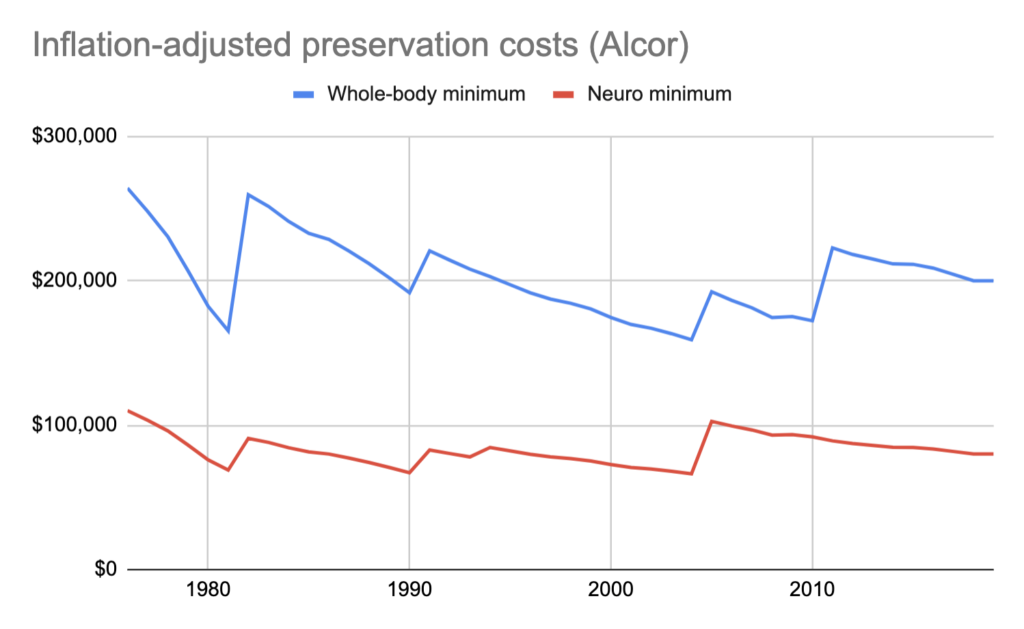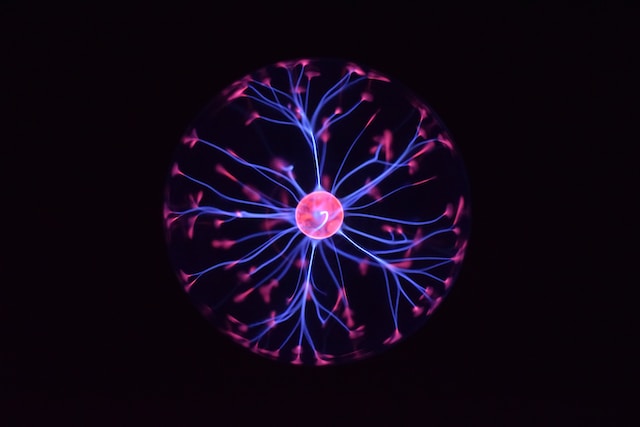It is often said that one cannot put a price tag on life. But what about the prospect of bringing someone back to life, with the help of cryonics? Cryonics involves the cooling of legally-dead people to liquid-nitrogen temperatures where physical decay essentially stops, in the hope that future scientific procedures will someday revive them and restore them to youth and good health. The person wishing to be preserved (“Patient”) enters into a cryopreservation agreement with the desired service provider. The whole process of cryopreservation is elaborate, and entails expenses peculiar to itself. This article sets out the factors based on which the cost of cryopreservation is determined, and how it varies from one service provider to another.
The Cost
Since cryonic service providers are under a legal obligation to keep their Patients in a preserved state, they require the whole process to be funded by the Patient beforehand, when they sign-up for the service. Adequate funding is necessary, and is to be done by the person desiring to be cryopreserved. Shifting this burden onto relatives has not proved to be fruitful, as there have been numerous instances of them losing interest, or being unable to continue paying, leading to the failure of their cryo-suspension.
Cryopreservation is a sophisticated procedure, and the costs associated with it can be broadly divided into two aspects: the initial procedure of conducting cryonic suspension, and the long-term preservation of the suspended Patient. The Alcor Life Extension Foundation (“Alcor”) and the Cryonics Institute (“CI”) in the United States, and KrioRus in Russia are the three premier cryonics service providers. The table below details the fees charged by these service providers:
Cryonics Service Provider | Whole-body Preservation | Neuropreservation | # of Patients | |
|---|---|---|---|---|
Data accurate as of May, 2021 | ||||
Alcor (inclusive of Standby services) | $200,000 | $80,000 | 182 | |
Cryonics Institute (provides optional standby at an additional cost of $60,000) | $28,000 (Lifetime member)
$35,000 (Yearly member) | N/A | 200 | |
KrioRus | $36,000 | $18,000 (members from abroad)
$15,000 (Russian Citizens) | 80 |
An up-and-coming service provider is the German-based cryonics company, Tomorrow Biostasis. They have a comparatively different pricing model as detailed in the table below. They charge a monthly fee consisting of two components: a monthly fee, and a coverage fee:
Plan Name | Monthly Membership | Coverage Fee (per month) |
|---|---|---|
Data accurate as of May, 2021 | ||
Essential+ | $30.40 | $12.16 |
Premium | $30.40 | $30.40 |
Platinum | $30.40 | $91.19 |
As observed, there are significant price gaps between the different service providers. This is due to the ancillary expenses associated with cryopreservation, which is dealt with in the following paragraphs.
“Standby” services
For effective cryopreservation, it is necessary for the procedure to be started immediately after the Patient is pronounced legally dead, ideally within the first 5 minutes. Since the window is this narrow, it requires the presence of a standby team, trained in conducting the preliminary procedures. A standby team will be deployed to the place where the terminally ill patient is obtaining treatment. This ensures that, immediately after the Patient’s death, they will be treated with protective medication and given a blood washout for additional metabolic stabilisation. Cardiopulmonary support is provided to minimise tissue injury when the heart stops functioning. Immediately following this, the body is transported to the cryonics facility on time, to begin the suspension procedure.
All of this entails a number of expenses such as: cost of the standby team personnel; an authorised nurse to pronounce the legal time of death, following which the procedure can be started; food, lodging and local transport for the standby team, and their equipment. This can become even more expensive when the Patient that is expected to die within a few hours ends up surviving a few more days, or even weeks.
Alcor provides these services through its Comprehensive Member Standby (CMS) plan, a pool of funds to which each member contributes $25,000, paid as a part of the cryopreservation fee. This covers all the expenses from the moment the Patient is pronounced legally dead until the body is received by Alcor. However, the CMS plan is not made available to members living outside the US and Canada, who will have to make their own arrangements for standby services, and pay accordingly.
The Cryonics Institute on the other hand, gives their members the option of including standby services in their membership. For those who opt for it, the standby services are provided through Suspended Animation Inc., at the fixed rate of $60,000. Again, these services are restricted to the United States.
KrioRus treats standby services as independent and charges separately for them.
Tomorrow Biostasis utilises the funds from its Monthly Coverage Fee to provide medical standby services. All of their plans include standby services, with teams stationed in Berlin and Netherlands.
Payments to Personnel
When cryonics first began, the institutes were run by volunteers, working solely towards the progress of cryonics. However, as they grew, they transitioned into professionally-run organisations, with employees on pay-roll. Procedures such as perfusion, etc., are carried out by skilled physicians and surgeons. The staffing has significantly increased due to the wider scope of operations, and an increase in the number of cryonically suspended patients has led to a proportional increase in maintenance requirements. All of these form a significant part of the expenses incurred.
Alcor sets aside $60,000 from the $200,000 charged for a whole-body cryopreservation, and $30,000 from the $80,000 charged for neuro preservation, to fund the process and pay the specialists involved. There is no breakdown of costs available for the other two service providers.
Tomorrow Biostasis funds their medical team and any training through its standard monthly membership fee, whereas the cost of cryopreservation is done through the coverage fee.
Long-term preservation and operational costs
The ultimate goal of cryopreservation is to bring those who are preserved back to life, to “reanimate” them. However, the progress of medical science in this regard is yet to take place. This essentially means that Patients are to be preserved for a number of decades. This gives rise to a continuous and indefinite maintenance cost, which consists of paying rent and utilities, replacing liquid nitrogen, maintaining and replacing dewars. These services are to be provided in the best possible way as capsule failure has previously resulted in bodies being thawed out and buried away, thereby rendering cryopreservation unfruitful.
Bodies are stored in dewars – cylindrical structures with columns – and at Alcor, these are called “Bigfoot”. The liquid nitrogen needed to fill these costs approximately $0.125/litre to $0.50/litre. The cumulative cost of liquid nitrogen depends on the “boil-off” capacity of the dewars, which is approximately 10-11 litres/day in the case of the Bigfoot.
These expenses are factored in as “long-term preservation” costs, which account for the largest portion of the expenditure. To foot this bill, cryonics centres need to receive a constant income. Alcor, for example, has constituted a Patient Care Trust (PCT) to fund these expenditures. From the fee received when members sign up for cryopreservation, $115,000, in case of whole-body preservation, and $25,000, in case of neuro cryopreservation, are allocated to the PCT, to be used for long-term preservation and potential reanimation.
Tomorrow Biostasis also uses a similar Patient Care Trust, which will ensure the availability of funds perpetually through low-risk investments. The quality of cryopreservation, the facility, as well as the funds available for these depends on the level of membership one opts for.

Inflation
Since cryonics centres have to continually procure materials, pay their staff, among other expenses, they would have to adjust their prices according to the prevailing inflation rates. The costs essentially should “catch-up” with inflation. Interestingly enough, the Cryonics Institute continues to charge the same fee of $28,000 or $35,000, depending on the nature of membership, since its inception. There has been no price-inflation adjustment.
On the other hand, Alcor has constantly increased its prices to keep up with inflation. There has been a steady increase from $60,000, charged for whole-body cryopreservation in 1976, to the current price of $200,000. For neuro-cryopreservation, the rate in 1976 was $25,000, whereas the prevailing rate is $80,000. Periodic price increases had to be made to keep apace with inflation rates as the value of money falls periodically. The following graph exhibits the inflation-price adjustments made by Alcor over the years:

Graph depicting the Whole-body and Neuro Cryopreservation Minimums charged by Alcor when adjusted with the prevailing rates of inflation. Graph created using data from Choosing a Cryonics Provider | Lesswrong and Inflation Calculator.
The graphical representation clearly represents the need to continually adjust the price of cryopreservation with the applicable inflation rates. Therefore, inflation forms a crucial part of the cost of cryopreservation, as facilities need to be able to keep afloat.
Miscellaneous
While the aforementioned are general expenses and form a major part of the process, the costs are structured after taking certain other expenses into account too. These consist of funds to combat unforeseen risks, emergency procedures, to fight lawsuits, etc. Tomorrow Biostasis uses Monthly Membership fees to fund research and development in cryopreservation and development of revival technologies, through the life-time membership, or periodic yearly membership payments. The Cryonics Institute charges $1,250 for a lifetime membership, and $120/year for annual memberships. Alcor charges membership dues amounting to $55/month.

Other costs associated with cryonics, such as revamping state-of-the-art facilities, among other things, have also increased due to inflation. Another contributor to the high-cost of cryonics is the small pool of clients; even though we have seen a rise in the number of patients, costs are bound to decrease, or at least stabilize, with enhancements in technology, and also if more people sign-up to be cryopreserved.
The only unknown aspects of these costs are those related to the reanimation of patients and their reintegration back into society. As there is no empirical data available to base these expenses on, companies can but estimate these costs by analyzing any new developments in medical technology.















